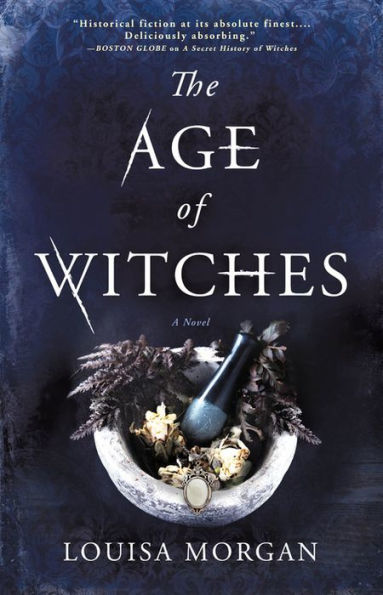Annis Allington, a daughter of the New York nouveau riche , wants nothing to do with the societal conventions of the 1890s. Her ambitions are to breed her prized Thoroughbred stallion, Black Satin, and enter the market with a strong bloodline of horses. Not very ladylike. But her stepmother, Frances, has other plans: mainly, to use her stepdaughter’s inheritance to secure a title and climb up the ranks of society. Frances whisks Annis to London to marry her off and lay her trap. Only when Annis’s Aunt Harriet Bishop comes to the rescue does the young girl realize she’s caught in a battle between two powerful witches that will decide her fate, and the future of her family’s power.
A story of bloodlines, magic, and love, The Age of Witches by Louisa Morgan is a bewitching coming-of-age story set against the backdrops of Gilded Age New York and London.
The Age of Witches hooks you in from the start, its characters lively and complex and layered. Harriet is haunted by a past mistake, while Frances is trying to shed her past. Even those with less page time, like the maids Velma and Grace, or Lady Eleanor are well-rounded. While the strega may fall into a caricature of Italian nonnas, even she has some depth. The Age of Witches has a decidedly feminist tone to it, and this theme of women’s freedom through magic or self-means runs throughout the story. It is not overbearing in its portrayal of the limited choices afforded to women in the past, but it is a gentle reminder of how far (yet also how little) women have come in terms of economic freedom.
Buy the Book


The Age of Witches
Annis, of course, shines as the heroine with her spunky ambitions and thirst for knowledge. She is every headstrong girl with a dream, clashing with her parents as to her future, but she is also compassionate and empathetic. It is Annis’s empathy and kind heart that helps awaken her to her inherited power and fight against her stepmother’s evil ways.
Magic is a birthright that has been hidden from Annis, first by her deceased mother and grandmother, and then by her stepmother, Frances. As a descendent of Bridget Byshop, a woman who was tried and burned as a witch in 1692, Annis has access to immense power and knowledge. Under the right tutelage, it can be used for good or evil. A chance encounter with Harriet leads to a small lesson in herbalism for Annis, yet her true first encounter with her family’s magic isn’t apprenticeship but manipulation. Her stepmother, Frances, employs dark magic known as the malefecia to control her. Pitted against Harriet’s herbalism, it’s a classic good witch vs. bad witch trope, light vs. dark, with Harriet embodying the generous grandmas of folklore, while Frances is the cunning, beautiful seductress.
The shared bloodline of the Bishops elevates this trope from innate nature to choice. Before Bridget is burned at the stake, she declares she will pass down the malefecia to her daughters and descendants, as well as her power to use as inspiration in the future. With two daughters of opposing nature and the history of how women with abilities are treated, it’s up to the individual witch to decide which path she’ll take.
While the majority of the book focuses on this family of witches and their struggles with power, Morgan makes sure not to leave the romance plot floundering. Annis is taken to London to setup a marriage with James Rosenfield, newly titled as Marquees of his estate after his father’s death. But along with that inheritance comes debt, and marriage into wealth seems like the only financially viable option.
The setup of James’s need to marry to save his estate again echoes the limited choices of freedom that women have – although that limited choice can work in a woman’s favor, like Frances made it work for her. It’s that juxtaposition between her own marriage, and the one she is trying to force for her stepdaughter that makes her plan both ironic and evil.
Although the meet-cute between Annis and James isn’t perfect, it’s clear the two of them would get along well, rules of propriety aside. The common bond between the two is their love of horses, but as they get to know each other an unspoken acknowledgment of affection and attraction grows. Of course, this relationship is tainted by the malefecia, but it is in essence the one relationship worth saving in the story.
The Age of Witches by Louisa Morgan is a delightful read imbued with magic that tells a story of power and legacy. Whole essays can and have been written about the word witch, and what it means to each progressive generation of women, who have increasingly reclaimed the word or identity. By setting this story during a time of social change in New York, The Age of Witches also becomes a novel about learning to embrace your own magic and power and using it for good.
The Age of Witches is available from Redhook.
Gabriella Tutino is a NYC-based freelance court reporter, writer and book reviewer. Her work appears on Tor.com, Comics MNT, the US Review of Books, and Highbrow Magazine. Her favorite topics are mythology, anime, and fashion. You can find her travel blog here and follow her on Twitter @gabriellatutino.










